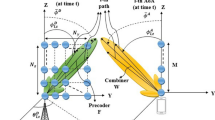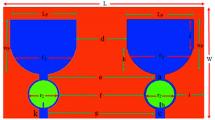Abstract
In this paper we consider joint waveform and filter design in multi-input multi-output (MIMO) radars in the presence of signal dependent interference to improve signal-to-interference-plus-noise ratio (SINR) of received signals. We have proposed two new iterative methods for this in which instead of direct design of waveforms, the coefficients of orthogonal waveform combinations are designed. In the first method, coefficients of combinations are calculated by solving a convex optimization problem. By extending the first method, we have proposed a method for multi-target case in presence of signal dependent interference. However, the computational complexity of the first method is high and therefore we have proposed the second method, which is more suitable for real time applications. In the second method, in each step, waveform combination coefficients and received filter coefficients are designed in closed form. Simulation results show that the proposed methods can achieve higher SINR in comparison to other methods which are used in MIMO and phased array radars.







Similar content being viewed by others
References
Li, J., & Stoica, P. (2009). MIMO radar signal processing (Vol. 448). New York, NY: Wiley.
Li, J., & Stoica, P. (2007). MIMO radar with colocated antennas. IEEE Signal Processing Magazine, 24, 106–114.
Haimovich, A. M., Blum, R. S., & Cimini, L. J. (2008). MIMO radar with widely separated antennas. IEEE Signal Processing Magazine, 25, 116–129.
Li, J., Petre, S., Xu, L., & Roberts, W. (2007). On parameter identifiability of MIMO radar. IEEE Signal Processing Letters, 14, 968–971.
Xu, L., Li, J., & Stoica, Petre. (2008). Target detection and parameter estimation for MIMO radar systems. IEEE Transactions on Aerospace and Electronic Systems, 44, 927–939.
Bekkerman, I., & Tabrikian, J. (2006). Target detection and localization using MIMO radars and sonars. IEEE Transactions on Signal Processing, 54, 3873–3883.
Stoica, P., Li, J., & Xie, Yao. (2007). On probing signal design for MIMO radar. IEEE Transactions on Signal Processing, 55, 4151–4161.
Hua, G., & Abeysekera, S. S. (2013). MIMO radar transmit beampattern design with ripple and transition band control. IEEE Transactions on Signal Processing, 61, 2963–2974.
Lipor, J., Ahmed, S., & Alouini, M.-S. (2014). Fourier-based transmit beampattern design using MIMO radar. IEEE Transactions on Signal Processing, 62, 2226–2235.
Jardak, S., Ahmed, S., & Alouini, M. S. (2014). Generation of correlated finite alphabet waveforms using Gaussian random variables. IEEE Transactions on Signal Processing, 62, 4587–4596.
Ahmed, S., Thompson, J. S., Petillot, Y. R., & Mulgrew, B. (2011). Finite alphabet constant-envelope waveform design for MIMO radar. IEEE Transactions on Signal Processing, 59, 5326–5337.
Ahmed, S., Thompson, J. S., Petillot, Y. R., & Mulgrew, B. (2011). Unconstrained synthesis of covariance matrix for MIMO radar transmit beampattern. IEEE Transactions on Signal Processing, 59, 3837–3849.
Stoica, P., Li, J., & Zhu, Xumin. (2008). Waveform synthesis for diversity-based transmit beampattern design. IEEE Transactions on Signal Processing, 56, 2593–2598.
Soltanalian, M., Hu, H., & Stoica, P. (2014). Single-stage transmit beamforming design for MIMO radar. Signal Processing, 102, 132–138.
Fuhrmann, D. R., & San Antonio, G. (2008). Transmit beamforming for MIMO radar systems using signal cross-correlation. IEEE Transactions on Aerospace and Electronic Systems, 44, 171–186.
Ahmed, S., & Alouini, M.-S. (2014). MIMO-radar waveform covariance matrix for high SINR and low side-lobe levels. IEEE Transactions on Signal Processing, 62, 2056–2065.
Liu, J., Li, H., & Himed, B. (2014). Joint optimization of transmit and receive beamforming in active arrays. IEEE Signal Processing Letters, 21, 39–42.
Imani, S., & Ghorashi, S. A. (2016). SINR maximization in colocated MIMO radars using transmit covariance matrix. Signal Processing, 119, 128–135.
Imani, S., & Ghorashi, S. A. (2016). Sequential quasi-convex-based algorithm for waveform design in colocated multiple-input multiple-output radars. IET Signal Processing, 7, 93–100.
Cui, G., Li, H., & Rangaswamy, M. (2014). MIMO radar waveform design with constant modulus and similarity constraints. IEEE Transactions on Signal Processing, 62, 343–353.
Imani, S., & Ghorashi, S. A. (2015). Transmit signal and receive filter design in co-located MIMO radar using a transmit weighting matrix. IEEE Signal Processing Letters, 22, 1521–1524.
Boyd, S., & Vandenberghe, L. (2004). Convex optimization. New York: Cambridge University Press.
Duly, A. J., Love, D. J., & Krogmeier, J. V. (2013). Time-division beamforming for MIMO radar waveform design. IEEE Transactions on Aerospace and Electronic Systems, 49, 1210–1223.
Chen, C.-Y., & Vaidyanathan, P. P. (2009). MIMO radar waveform optimiza-tion with prior information of the extended target and clutter. IEEE Transactions on Signal Processing, 57, 3533–3544.
Van Trees, H. L. (2002). Optimum array processing part IV of detection, estimation, and modulation theory (Vol. 1472). New York: Wiley.
Chen, C., Zhang, X., Chen, H., & Ben, D. (2013). A low-complexity algorithm for coherent DOA estimation in monostatic MIMO radar. Wireless Personal Communications, 72, 549–563.
Li, Jianfeng, & Zhang, Xiaofei. (2013). Closed-form blind 2D-DOD and 2D-DOA estimation for MIMO radar with arbitrary arrays. Wireless Personal Communications, 69, 175–186.
Author information
Authors and Affiliations
Corresponding author
Rights and permissions
About this article
Cite this article
Haghnegahdar, M., Imani, S., Ghorashi, S.A. et al. A New Iterative Approach in SINR Improvement of MIMO Radars by Using Combination of Orthogonal Waveforms. Wireless Pers Commun 97, 2069–2085 (2017). https://doi.org/10.1007/s11277-017-4596-2
Published:
Issue Date:
DOI: https://doi.org/10.1007/s11277-017-4596-2




